I’m going to be delving deep into some baking research over the next months. It will be near like Heston Blumenthal’s In Search of Perfection as I explore every nook and cranny of one baked good or another. Or, I may just try out a few different recipes, see what I think, and come up with one I like better. You know how things go. Besides, who’s to say that perfection only comes with effort? It’s prevailing wisdom, but that doesn’t mean it’s true.
And so, I’m starting with the scone. How did I get to the scone you might ask? Well, you see, someone turned me on to this British television series called The Great British Bake Off and I’ve become completely fascinated with watching my way through the series. And somewhere in the first couple of challenges of the first season, the contestants had to all make the same scone recipe given nothing more than the list of ingredients – a test of their technical skill. That led me to one of the judges, Paul Hollywood, and his books, which turned out to be available in ebook formats, so I decided to give the scone a go myself. And, away I went…
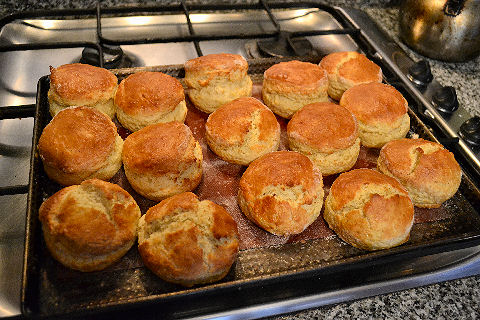
So first up, the scones that came out of the oven following Paul’s recipe. They were easy as can be to make. By the way, for this “challenge”, I followed the recipes to the letter, even if something seemed odd (nothing did in this one), to see the results as written. In the past when I’ve made scones they’ve always been made with pastry flour, much like a biscuit, so it was interesting to see a recipe that called for strong flour, like bread flour – I would have thought that the high gluten content would be a drawback. It used quite a bit of baking powder it seemed to me and I was worried about that sort of metallic taste, but no. Also, whole milk, and it seemed like a fairly high amount of liquid with the milk and eggs to the dry ingredients – the dough was very soft. The dough is mixed by hand, gently, and then folded over on itself several times in a process known as “chaffing”. And, an egg wash to give it color and shine atop. But, it worked, and worked beautifully as you can see, and was amazingly easy to put together – literally five minutes from the time I started until they were on the baking tray. A few minutes rest and then into the oven. The trio in the front left are the “re-rolls” of the scraps after cutting out the rest – you can see immediately how different they rise after having been mushed up together a bit and then rolled out again.
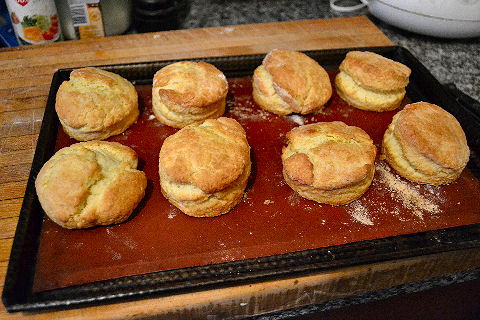
These follow the recipe that I learned when I was in cooking school. Interestingly, not from our pastry instructor, but from a fellow student, who was from Ireland, and shared her family’s recipe with all of us. I did make one minor change, just to be fair, I left out the raisins that the recipe called for as I want to just see how the dough itself works out. Here, the recipe calls for straightforward all purpose flour, again not cake flour. It also uses soured milk, baking soda and cream of tartare, and the proportions give a much stiffer dough – while the one above was so soft it seemed almost to quiver at the touch, this one could easily be pressed out by hand, shaped, and moved around a bit – it uses a very different mixing technique, basically stirring with a wooden spoon to bring it all together and then simply patting it out into shape, versus the chaffing process used above that involves folding it over and over on itself several times, and the rise is slightly irregular here. Her recipe doesn’t call for a glaze, so the finish is left dull. The result looks a bit more like a biscuit. In this case, the front left two are the re-rolls of the scraps, one of them dramatically different from the rest.
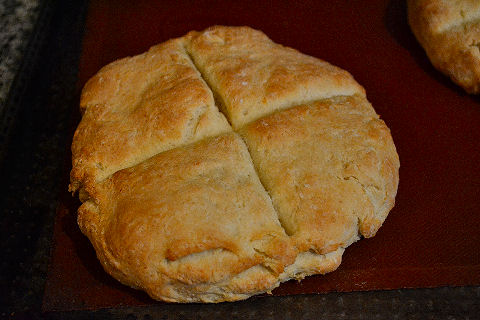
So, having mentioned my pastry instructor, Nick Malgieri, I figured I ought to see if he offers up a recipe in one of his books or on his blog. And, sure enough, he does. He goes for a more traditional Scottish style, both in form and, my sense, texture, which is a little denser than the other two already sampled. It also makes use of both butter and buttermilk. Since the latter is unavailable here in BA it required that I make some, which also meant making my own butter – so a liter of heavy cream quickly became around 440 grams of butter and a cup and a half or so of buttermilk. The process he uses for making it seems a combination of the other two – a quick and gentle mixing with a fork, rather than a wooden spoon (I’m following these recipes to a “T” just to see how that has them turn out), and then uses the chaffing process to finish. The dough is then divided in quarters, patted out into 5″ rounds, and cut with a pastry cutter to create the divides. I found that these didn’t have the rise of the other two – I’m wondering if it’s perhaps a difference between buttermilk made this traditional way and the more commonly seen these days “cultured buttermilk” which has more acidity and body – a query has been dispatched to Nick on the subject. I did find that following the recipe to the letter the scones were just slightly under-cooked when they came out of the oven at the appointed time, but since that could simply be oven temperature variation I stuck them back in for about 3-4 more minutes and then pulled them out, cooked through. Obviously given the need to make buttermilk here these aren’t quite as quick nor easy to make as the other two, but it really only added about 15 minutes to the process, and if you have access to buttermilk wouldn’t be an issue.
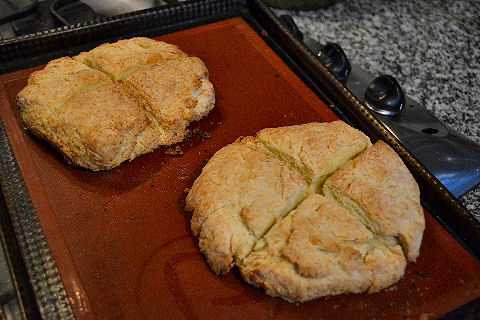
So, Nick got back to me and indeed confirmed that cultured buttermilk is quite different. His recommendation given the lack of availability here was a 2/3 mixture of milk and 1/3 of sour cream. Completely different results – light, flavorful, delicious and a great texture. Still a bit denser than the other versions, but gives me some ideas for my own recipe down the line. More explanations to come.
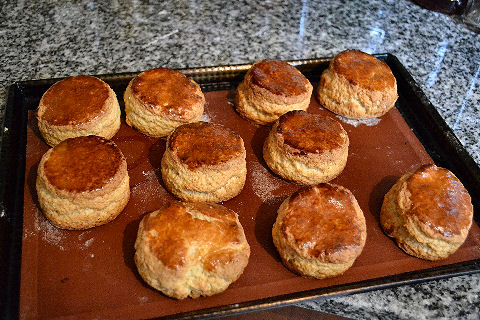
Decided to do a bit of online searching and looking for some of the top recommendations out there. It’s probably not surprising that the iconic Savoy in London is famous for their scones at afternoon tea. Finding a recipe online turned out to be a breeze as well, or at least a purported one from Martha Stewart’s magazine. Beautiful turn out, love the shiny top and the lightness. Interestingly this version uses straightforward lighter flour and whole milk. It has a fair amount of sugar – noticeably more than the other versions. In terms of process much like the first two versions.
Now let’s look at them from the insides and also compare taste.
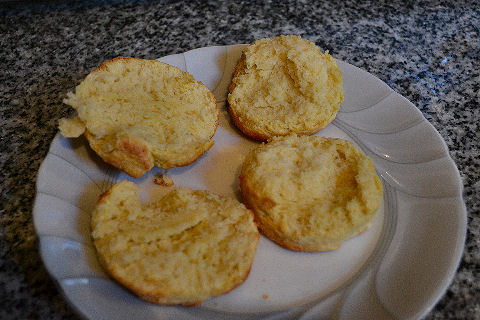
Back to Paul Hollywood’s recipe. Easy split to open them up. Inside, a good amount of irregular, small air pockets, almost like what you’d get with a bread dough that hadn’t been kneaded a long time – which in some ways is what this is. My first thought was that it’s the flour, being bread flour, but, there’s not any real kneading to develop the gluten, so that’s unlikely. I think it more probable that it’s the action of the baking powder. The taste is sweet – not overly so, but noticeable – there is a fair amount of sugar in the recipe, plus the fresh whole milk. They were excellent on their own and with butter, but I found that adding in a jam or syrup and it was overall too sweet for me, more like a full on pastry.
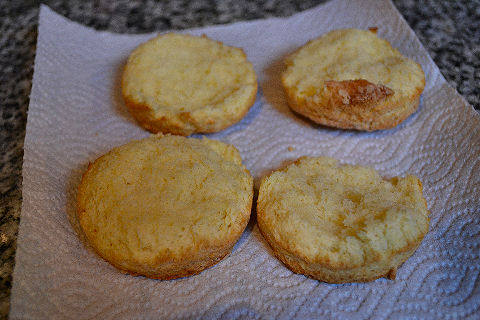
A return to my fellow cooking school student’s version. Again, quite easy to split open. Much finer grained inside, you can really see the difference compared with the ones above – almost cake-like in texture inside. Maybe it is partially the type of flour, and perhaps a difference in the action of baking soda and cream of tartare versus the baking powder above. The flavor is completely different, while still sweet, not as much, and balanced nicely by the tang from soured milk, which comes through particularly on the finish. I liked that better. To this point, I liked the texture of Hollywood’s scones and the flavor from the second ones better.
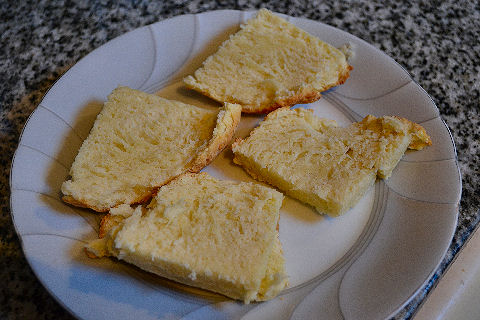
So, back to the Scottish version supplied by Nick Malgieri. I have to admit I found this version a little blander than the other two. It was missing the sweetness of the first and the sourness of the second. The triangular quarters also don’t split the way the others do – though that may be related to the lack of rise seen, since they were pretty dense. They seemed more suited to use with some stew ladled over the top than as a more delicate pastry. I had some leftover buttermilk so I made a quick smaller batch and got the same results, so hmmm… sorry Nick, but this one just doesn’t do it for me. However…
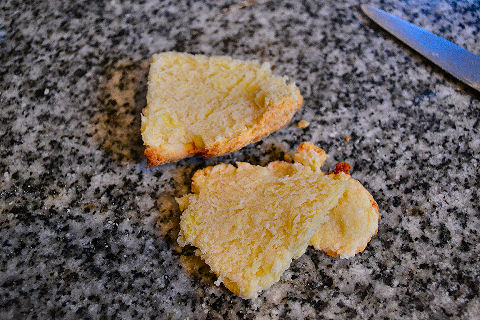
…the remake of this version with the change in the recipe as advised has the nice sharpness coming from the sour cream, though still missing a bit of the sweetness to balance it. With the lighter texture these were easy to split though I found them a little crumbly. A nice scone, but not my favorite so far.
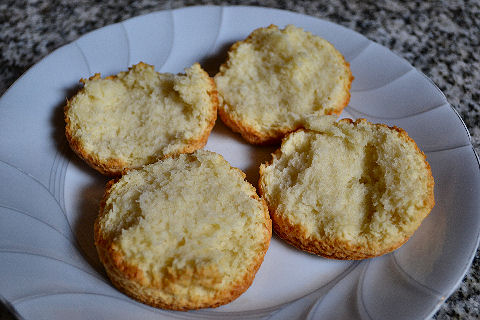
Very pastry/cake style from the Savoy/Martha Stewart. Probably appropriate for the afternoon tea setting versus being a breakfast scone. They were delicious, just a bit sweeter than I was hoping for and missing that little bit of sharpness that I found in the versions with soured cream or milk. On the other hand, Henry ate virtually the entire batch at one sitting, and he does like his pastries. So there. How can I argue with that?
To be continued in Scone Wars 2 somewhere in the near future….















Oh I loved this post! I just bought Bouchon Bakery book and wanted to make their scones, but they use cake flour and creme fraiche which I don’t know how to replace them here in BA!
I LOVE Nick, I have 2 or 3 of his books and he’s an amazing teacher..lucky you!
How did you got sour cream? cream+ lemon juice?
Exactly – I’ve found that the standard 360ml containers of cream here work perfectly – add the juice of one lemon and a half teaspoon of salt and let it sit out at room temp for about 4-5 hours until thick and tangy. Then refrigerate it and use as needed. But creme fraiche is different – for that what I’d do is take the same cream and add a tablespoon or two of active culture yogurt to it, no salt, and let it sit out overnight.
For active culture yogurt you mean Yakult or similar? or just no flavored yogurt such as Dahi?
Thanks for the tips! I’m now trying to substitute cake flour with flour+ cornflour…hope it works!
I think either will work – I’ve used both as starters for homemade yogurt so both clearly have active cultures. Obviously, unsweetened and unflavored is the direction to go here. You can just use 0000 flour here for cake flour, it’s nearly as light and lower in gluten – I’ve found it works well. And some of the dieteticas have even lighter flour for cake and pastry baking.
Hopefully I’ll be releasing installments of Scone Wars more often than George Lucas would. Then again, I don’t really plan to continue on to more and more sequels, in fact as I write this at the beginning, I’m thinking, maybe 4-5 more and then come up with my own recipe as the final result based on the research. We shall see.